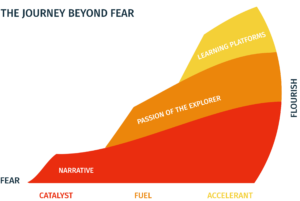Overcoming Fear
Do you need to overcome fear?
Based in Silicon Valley for over 40 years, John Hagel has been a strategist and futurist working with corporate and other leaders around the world to help them understand how the world is changing and the implications for how to harness the opportunities ahead. He has just published his eighth book, The Journey Beyond Fear, which urges all of us to pay more attention to the emotions that are shaping our choices and actions. Over the years, John has come to believe that psychology is even more important than strategy – our emotions will determine what we see when we look out at the world and how we act in that world.
After a global pandemic, and in the midst of disruption and massive uncertainty, fear seems to be gripping more and more people into its spiral. Share some of your observations of where we are in this regard.
The pandemic certainly intensified the fear of many, but my book suggests that fear was increasingly spreading around the world well before the pandemic emerged – at the highest levels of organizations, on the front lines and out in the community.
We are in the early stages of a Big Shift where long-term forces are re-shaping our global economy and society. These forces are creating mounting performance pressure for all of us. Competition is intensifying on a global scale – for companies and for individuals. Individuals are increasingly worried about their jobs being taken away by robots or by employees in lower-wage countries. The pace of change is accelerating – things we thought we could count on are no longer there. And, as if that weren’t enough, the global connectivity we have created enables small events in some far away place in the world to quickly cascade into extreme, disruptive events that leave us scrambling to figure out what to do – dare I mention pandemic?
That’s a lot of pressure and, given the forces at work, the pressure will continue to intensify over time.
So, there are reasons to be afraid. The spread of that emotion is understandable. But that emotion can be very limiting. It tends to shrink our time horizons, makes us much more risk averse and much less trusting of others. We all have a need and an opportunity to move beyond fear and cultivate emotions that will help us to move forward and achieve much greater impact that is meaningful to us and to others.
Let’s get into your three pillars to help us move beyond fear, pillars of positive emotion:
Would you share the difference between narratives and stories and how can we use them positively?
I make an important distinction between stories and narratives. Stories are self-contained – they have a beginning, a middle and an end. Stories are also about the story teller or about some other people, real or imagined – they’re not about you.
In contrast, for me, narratives are open-ended – there is no resolution yet. There’s some kind of big threat or opportunity out in the future, and it’s not clear whether it will be addressed or not. The resolution of the narrative hinges on you – it is a call to action to people in the audience, making it clear that their choices and actions will help to determine how the narrative resolves.
I also make a distinction between threat-based narratives where the focus is on a significant threat out in the future and opportunity-based narratives which focus on a significant, inspiring opportunity out in the future. Threat-based narratives feed the emotion of fear while opportunity-based narratives can be catalysts for emotions like hope and excitement that motivate us to move forward in spite of the fear.
My book discusses many different levels of narratives. We all have personal narratives that shape our individual emotions. Companies and other organizations can craft institutional narratives. Cities, regions and even countries can craft geographical narratives. And then there are movement narratives that seek to motivate and mobilize participants to take action.
There are untapped opportunities at all levels of narratives, but let me focus on institutional narratives. Very few companies have institutional narratives in the way I define them. These narratives should not be about the company but instead should focus on framing an inspiring opportunity for their customers and have an explicit call to action for the customers.
One company that developed this kind of narrative was Apple Computer back in the 1990’s. The narrative was condensed into a slogan of “Think different,” but if we unpack the slogan, the narrative was that, for decades, we had digital technology that took away our names and gave us numbers and made us cogs in a machine. Now, for the first time, there was a new generation of technology that could help us to express our unique potential and individuality. But it wouldn’t happen automatically. To address this opportunity, we had to think different. Would we think different?
This narrative was not about Apple, it was about the customers. It spoke to such a deep aspiration that many of us had that, for many, Apple became the equivalent of a religion. In a world increasingly dominated by fear, this kind of corporate narrative can build deep loyalty.
You discuss the passion of the explorer derived from your research. How do we cultivate this passion in ourselves and in our teams?
My research led me to focus on a very specific form of passion – the passion of the explorer. This passion has three components. It starts with a long-term commitment to achieving increasing impact in a specific domain. People with the passion also have a questing disposition – they are excited when confronted with unexpected challenges, and they are constantly seeking new challenges as an opportunity to have more impact in their domain. And then this passion also includes a connecting disposition – people with this passion are actively seeking to connect with others as they address the challenges ahead because they believe they can have much greater impact if they can motivate and mobilize others to help address the challenges.
Unfortunately, our companies and other institutions are deeply suspect of this passion, so they actually discourage it. That’s why my survey of the US workforce indicated that at best only 14% of the US workforce has this form of passion about their work.


